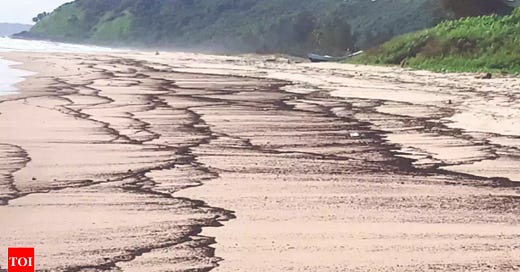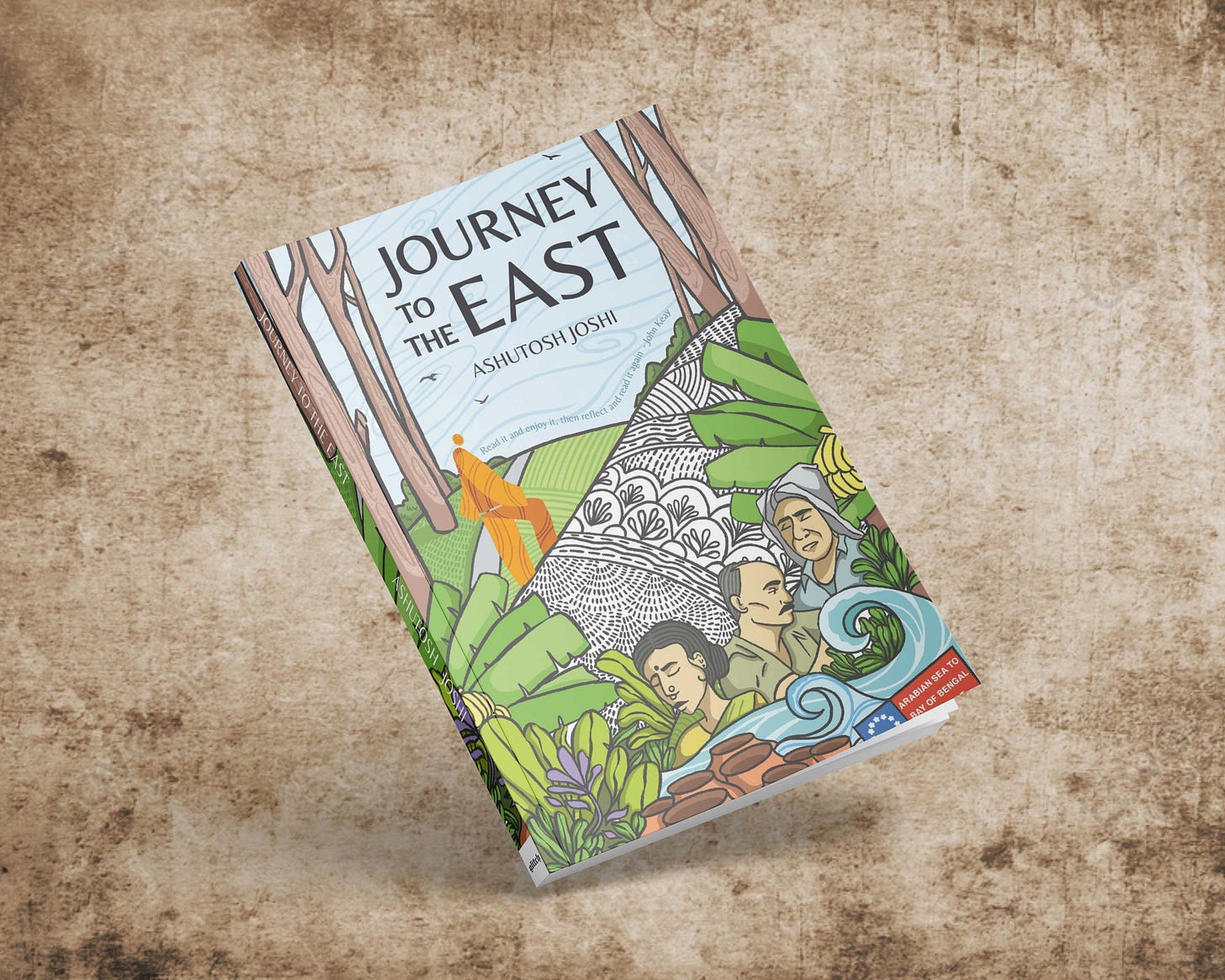Kokan was always lush. Sandwiched between Sahyadri Mountain range and the Arabian Sea, Kokan often looks like a green rug which was spread around by God to enjoy her creation. I imagine her sitting in a resting chair amidst all the coconut and betel-nut trees, sipping tender coconut water while she enjoys the salty breeze that the sea brings. She must have liked it so much that she invited all of us to live here.
The only way to live here is to be laid back and move extremely gently, not any faster than the afternoon wind. The right pace is that of the sutar pakshi (carpenter bird)- if one can move as gently as he does when he builds his nest, you have experienced the stillness of Kokan. Kokan is not just my village, it is spread over a 500 km stretch and everything that falls in that sandwiched area is called kokan. It is believed that a man named Parshuram, who is said to be an avatar of God, stretched his arrow and sent it towards the sea and where it landed the sea receded itself to that mark, thus giving birth to Kokan. Other story says that he fought with the sea and won this land over. Whichever story you want to believe, you can. After all people who live here are always eager to believe in a new story.
Now, why am I giving you a background to Kokan?
Today I am writing about the changes that have occurred in our surroundings and how we, as a village, are trying to find ways to keep this lush rug, filled with greenery, in its original state, like the Gods gave it to us.
I had returned from a month long assignment in Vietnam, where I was amazed to see the incredible detail to nature management. While I sat on the banks of the Son river with my American friend, we were gazing at the men and women who were gently rowing their boats past us while they cleaned the river. They would use two long bamboo chopsticks to scoop out the excess weed and store it in their boats.
I reminded myself of Narvan- we too had a clean river flowing through the village which even had a systematic water channel that went through the wadis without any electricity. Dams and check-dams were built on intervals by the village community, and this was pre-government era. The village community carried out this work. Now that the Indian government is the new “East India Company” of India, all these dams, check-dams, channels have been forgotten. We are lucky if a project comes in some ten years and are always certain that this work is going to be below-standard. The materials used in it would be average at best. All this has given rise to a polluted river.
Elders used to say that boats came in some 3-4 km into the village. The creek was deep and it used to be cleaned timely, but not anymore. Rocks and silt deposition for over 70-80 years has almost filled the river to its brim. Now, it is difficult to distinguish between the river and the farm in summer, when there is no water in it. The sea and the beach too finds the same fate. Jairam ajoba, who was the oldest in our village, 95, when he died last year, reminded us about his childhood memories. The beach was far into the sea, he used to say, rising sea levels have pushed the water inwards. The waste coming out of the sea was always sticks, logs and washed out trees. We, I am included in this we, saw occasional blue whales in the sea. We called it dev maasa - god fish (dev as in Dev Patel). My wildest memory is that of a blue whale that was washed on the shoreline when I was 7 years old. It was the size of couple double-decker buses kept on top of each other. I remember vividly, young kids were dancing on top of it, and this wasn’t a long while ago.
It has been only some 15-20 years in which all this change has occurred. The first project to come on this shore was Enron, in 1992. An American company that neglected the protests and complaints from locals eventually died out owing to numerous scandals in other parts of the world. You can read the human rights report here. This company paved the way for many other companies which would eventually set base on this shoreline. Ministers from the Maharashtra government often quoted that this was to turn Kokan into California, that this was to push kokan into the future, but the indigenous tribes and other villagers knew better. They had seen this for some while and they knew by now that none of this was for them, it was pushed to eventually fill the pockets of those ministers. Protests have been common since then.
The only project that saw a mild protest was that of Jindal Power Plant in the Jaigad Creek. Jaigad, a thriving town, which once nestled the fort of the most revered Indian king, Shivaji Maharaj, was proposed as a site to the Jindal Power Plant. Many promises were made, education, clean roads, clean air, jobs, but these promises are like vapour on the tea, it’s only seen when the tea is hot. The villagers willingly gave their land in less price and thus started the expansion of JSW. Later, many other corporations acquired land in the creek- these were age old forests which were preserved by the indigenous communities. One by one these forests were chopped down and in came the ship-repair works, scrapyard. Jindal was building a huge wall in the sea to dock its mammoth ships that were coming all the way from the other side of the sea. Locals watched this destruction first hand, now cornered in a tiny place. Many left to Mumbai and the ones remaining had to work as coal gatherers in the power plant. “JOBS” that this power plant was going to offer, was for locals to pick the coal that fell down from the conveyer belts when it was transported from the ship to the yard.
Narvan was watching this from afar. We watched how this little paradise, which was just across the creek from us, was chopped down to an extent that the land is now parched. Since then the locals have made it a habit to not sell their land to anyone. Thus, although the land prices have shot up, you will hardly see any signs saying “LAND FOR SALE.” We know how important this land is to us.
Since Jindal has come in, we have seen a huge change in the sea. The once clean sea is now filled with plastic and oil waste. A few years back, a ship that was bound to Jaigad sank near our coast. It scattered the oil that it was carrying, leaving behind a trail of dead fish and plants all along the coastline. We thought this was by mistake, so we let it go, but then it happened again and again and again. This study shows how much area around the coast has oil spills.
We know that we are helpless. The locals feel the intensity of pollution when they take their crop. In the past, anything that they threw into the ground bloomed. Rice, nachani and other cereals didn’t need any excessive pesticides or insecticides to bear crop, but since the incoming of industries and excessive air, ground and water pollution, things have changed. Sanju dada says this quite often, that he has experienced a downward trend in crop yield.
This is enough background for the next story- where we came together as a community to find a way to deal with this situation.
I thank you all for subscribing. There has been an influx of subscribers in the past few days. Thanks to
’s recommendation, the number keeps growing.If you are still here, I would take this moment to direct your attention to a book I have written. This book is almost 2 years in the making. In 2022 I left off on a walk across India and ended up walking 1800 km from Narvan on the west shore, to Visakhapatnam on the east shore. Initially to document the issues plaguing rural India, the project unfolded to become an unforgettable voyage of self-discovery; involving sleeping in unfamiliar places, venturing alone through the Naxalite insurgent jungles, and even being interrogated in a jail cell.
After contemplating on what is the right way forward, I have come to the conclusion that I will self-publish it. It is already with the printers and the first copies will be sent out all around the world this coming 25th. If you are interested in reading about my journey and supporting me to become a full-time writer, please consider buying “Journey to the East”- which is currently available through my website. www.ashutoshjoshi.in
Wait! Before you go, will you take one moment to hit that SHARE button? This one simple action can be surprisingly effective at helping to spread the word and build my readership. Thank you! And remember, upgrading to a paid subscription will help support the hard work behind The Book of Ptah, and tips are very much appreciated. 💚
paypal, www.paypal.me/ashutoshjoshistudio
You can buy my first book “Journey to the East”, a memoir about an 1800 km walk through India, through my website .
If you would like to buy prints of my photographs, you can choose the photographs you like on my website and send me an email. I will send you custom quotes for the sizes you’d like.







